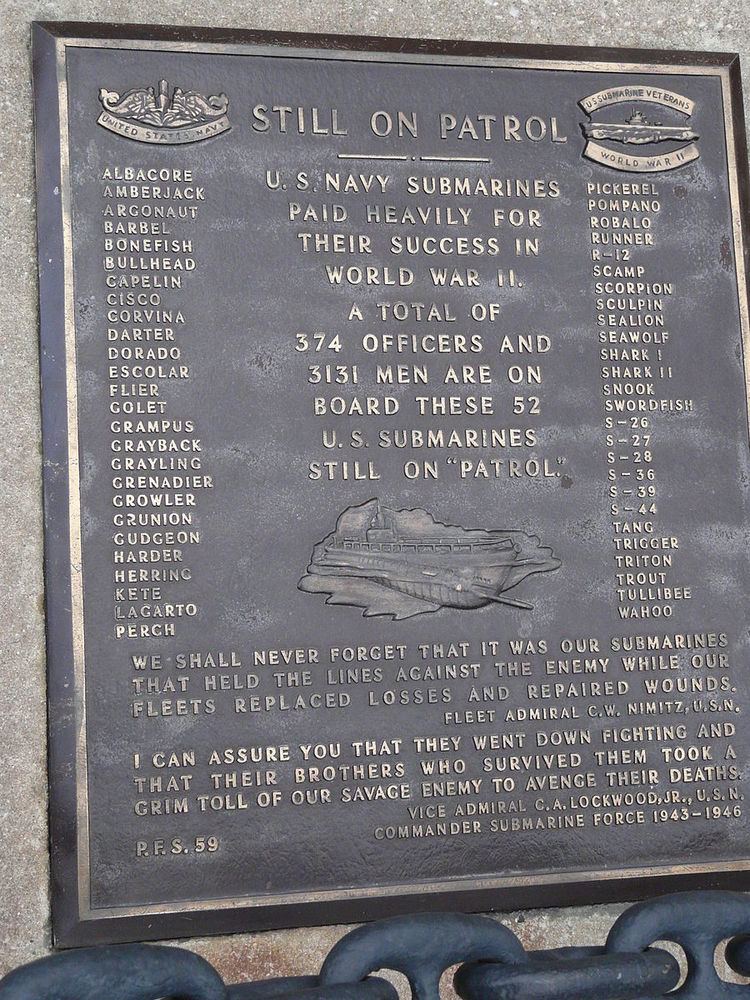 | ||
These United States submarines were lost either to enemy action or to "storm or perils of the sea."
Contents
Before World War II
Additionally, USS S-48 (SS-159) foundered 7 December 1921 in 80 feet of water on a pre-commissioning dive. She was raised and commissioned 14 October 1922. USS G-2 (SS-27), decommissioned as a target, flooded and sank unexpectedly 30 July 1919 in Two Tree Channel near Niantic, Connecticut with the loss of three crew.
During World War II
During World War II, the U.S. Navy's submarine service suffered the highest casualty percentage of all the American armed forces, losing one in five submariners. Some 16,000 submariners served during the war, of whom 375 officers and 3131 enlisted men were killed.
Fifty-two submarines of the United States Navy were lost during World War II. Two -- Dorado (SS-248) and Seawolf (SS-197)—were lost to friendly fire (with S-26 (SS-131) probably additional friendly fire, as the collision with USS Sturdy (PC-460) appears due to being mistaken for a U-boat), at least two more --Tulibee and Tang—to defective torpedoes, and six to accident or grounding.
Another eight submarines went missing while on patrol and are presumed to have been sunk by Japanese mines, as there were no recorded Japanese anti-submarine attacks in their patrol areas. The other thirty-three lost submarines are known to have been sunk by the Japanese.
Additional casualties
There are two additional casualties to submarines in World War II that are sometimes considered as effectively two additional losses, plus the loss of one S-boat used as an experimental hulk. USS Halibut (SS-232) was damaged by Japanese air and surface forces on 14 November 1944. She was able to reach Saipan and later Pearl Harbor on 1 December, departing San Francisco for Portsmouth Navy Yard on 16 February 1945.
There it was determined that she was beyond economical repair, but might be useful as a school ship, similar to the postwar immobile pierside training submarines. However, her career in this capacity was brief, and Halibut was decommissioned at Portsmouth Navy Yard 18 July 1945 and sold for scrap in January 1947.
USS Lancetfish (SS-296) was commissioned on 12 February 1945 and sank at pier 8 at the Boston Navy Yard on 15 March 1945, apparently without loss of life and reportedly still incomplete. She was raised eight days later, decommissioned on 24 March 1945, and never completed or fully repaired. Postwar, she was listed as a Reserve Fleet submarine until stricken in 1958 and scrapped in 1959, having never gone to sea.
The former USS S-49 (SS-160) was sold in 1931 to a private owner for use as a tourist attraction, with the hulk reacquired by the U.S. Navy for "experimental purposes" in 1941. She foundered and sank in the Patuxent River 16 December 1942.
State adoptions
The United States Submarine Veterans of World War II have suggested each of the fifty states of the United States "adopt" one submarine, except California and New York, which should adopt two.
After World War II
The USS Bugara (SS-331) was decommissioned and struck from the Naval Register 1 October 1970. On 1 June 1971, while under tow near Cape Flattery, WA, Bugara swamped and sank accidentally.
Additionally, USS Guitarro (SSN-665) flooded and sank pierside prior to commissioning at Mare Island Naval Shipyard on 15 May 1969. Two shipyard teams, apparently unaware of each other's efforts, were conducting work involving filling tanks in both the forward and after portions of the submarine. Eventually the lack of coordination led to flooding through the bow hatch. The submarine was raised, but completion was delayed 32 months. Guitarro was commissioned 9 September 1972.
USS Bonefish (SS-582) was not repaired after a fire near Florida on 24 April 1988 that killed three crewmembers. She was decommissioned 28 September 1988 and hulked 17 August 1989. The hull was later purchased by Northrop Grumman for testing.
USS Miami (SSN-755) experienced a fire during overhaul at Portsmouth Naval Shipyard on 23 May 2012 that caused significant damage, though with no loss of life. A civilian shipyard worker confessed to arson. Although repairs were considered, using components from the decommissioned USS Memphis (SSN-691), the estimated cost of $700 million was considered uneconomical in a time of reduced budgets. Miami was decommissioned on 28 March 2014, to be disposed of via the nuclear Ship-Submarine Recycling Program.
